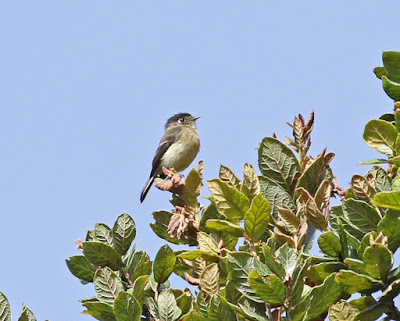The morning started out a little foggy before turning
into a beautiful day. We didn’t have to
get very far from the car before we started seeing lots of birds. Most of the birds at these very high elevations are the endemic species found only in these cloud forests of Costa Rica and western Panama.
Our first find was a male Black-and-yellow Silky-Flycatcher. There are only two members of the Silky-Flycatcher family found in Costa Rica, the other being the Long-tailed Silky-Flycatcher (see Day 5).
Down in the brush we heard the song of the Timberline Wren. While some references say that you've got to get to the timberline (the elevation where trees no longer grow) to see this species, Marino knew that a small population lived in this area. After waiting patiently the sneaky little bird finally revealed itself.
Black-and-yellow Silky-Flycatcher
Timberline Wren
Another tiny, high-elevation bird is the Black-capped Flycatcher.
Black-capped Flycatcher
There is a special hummingbird in the region called the Fiery-throated Hummingbird. With a name like that you'd think it would be amazing to look at, right? The problem is that the "Fiery Throat" is displayed only rarely, and can be seen only with exactly the right light. We saw several and I took many pictures of this one not displaying it's throat.
Fiery-throated Hummingbird
When it did decide to flash it's gold/orange/yellow throat for about a micro-second, the single shot that I got wasn't exactly in focus! Oh well, maybe next time...
We saw a few other species, including a Large-footed Finch, who's feet seem about the same size as other birds!
We spent an enjoyable couple of hours in the park before heading up to the Paramo (alpine tundra ecosystem). Our target bird was the Volcano Junco. It happened to be the first bird we saw and we only saw one.
Large-footed Finch
We also managed to get looks at a Yellow-billed Cacique. Most Caciques are noisy, obvious birds that aren't hard to find at all. But the Yellow-billed Cacique is the exception, being quiet and rather shy.
Yellow-billed Cacique
We spent an enjoyable couple of hours in the park before heading up to the Paramo (alpine tundra ecosystem). Our target bird was the Volcano Junco. It happened to be the first bird we saw and we only saw one.
Volcano Junco
At one point the bird kind of gave us the evil eye. Those yellow eyes make it look mad.
We saw a couple of species of tiny little hummingbird in this cold, treeless area. We did notice plenty of flowers on the low shrubs and ground-cover.














From the quick and lazy internet search I did, true finches are in the Fringillida family (finches and Hawaiian honeycreepers), and the Large-footed Finch is in the Passerellida family (New World sparrows).
ReplyDeleteI didn't know that. Finches seem to be a loosely aligned group of birds, sort of like Tanagers. There are the pretty, small, colorful "true" Tanagers in Costa Rica and the bigger, less colorful ones like our Summer Tanager, which seem closer to Grosbeaks. Until the scientists change their minds, again...
ReplyDeleteAnother great post, thanks.
ReplyDelete